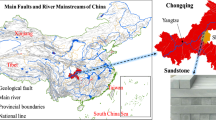Abstract
Soil is a heterogeneous material and most natural soil deposits show a definite stratification. The mechanical behaviour of such material is generally different in different directions, especially in the direction parallel and perpendicular to the stratification. A series of isotropic compression tests were carried out to study the behavior of granular material produced under controlled stratification in the laboratory. These tests were conducted both on cylindrical and square prismatic tri-axial specimens. It was observed that for hydrostatic loading, the strain response was different in different directions, especially in directions parallel and perpendicular to the direction of soil deposition. A definite trend of anisotropy was observed in the deformation pattern. The observed anisotropy is modeled in this paper by treating soil-dilatancy as a variable quantity. The equation of the plastic potential surface of the model which obeys a non-associated flow rule, is assumed to be dependent on three main variables confining pressure (\(\sigma_{3}\)), void ratio (e) and the angle of bedding plane orientation (δ) during deposition. The angle of bedding plane orientation (δ) was measured with respect to the direction of the major principal stress. The model has a cap yield surface in the isotropic stress direction, which is supplemented by a shear hardening Mohr–Coulomb surface in the deviator direction. This paper focuses on predicting the anisotropic strain response of stratified soil deposits subjected to isotropic compression. The proposed anisotropic model incorporates within an existing strain-hardening sand model, a modified cap yield surface and a modified plastic potential function related to the cap surface, to account for the anistropic response observed in isotropic compression tests. The two dimensional stress–strain model was extended to three dimensional Cartesian space. The strain anisotropy observed in the isotropic compression tests was predicted by the three dimensional anisotropic model proposed for granular materials.


















(Figure 21 from Lam and Tatsuoka 1988)





Similar content being viewed by others
References
Anadarajah AM, Dafalias YF (1986) Bounding surface plasticity. III: application to anisotropic cohesive soils. J Eng Mech ASCE 112(12):1292–1318
Argyris JH (1973) Recent developments in finite elements analysis of PCRV. In: SMIRT proceedings of 2nd international conference, Berlin
Arthur JRF, Menzeis BK (1972) Inherent anisotropy in sand. Geotechnique 22(1):115–128
Banarjee PK, Yousif NB (1986) A plasticity model for the mechanical behaviour of anisotropically consolidated clay. Int J Numer Anal Methods Geomech 10:521–541
Barlat F, Lian J (1989) Plastic behaviour and stretch ability of sheet metals part I: yield function for an orthotripic sheet under plane stress conditions. Int J Plast 5:51
Barlat F, Lege DJ, Brem JC (1991) A six-component yield function for anisotropic materials. Int J Plast 7:693
Dafalias YF (1987) An anisotropic critical state clay plasticity model. In: Desai CS et al (eds) Constitutive laws for engineering materials: theory and applications, Proceedings of 2nd Intern. Conf., Elsevier, New York, Amsterdam, pp 513–521
El-Shoby MA, Andrawes KJ (1972) Deformation characteristics of granular materials under hydrostatic compression. Can Geotech J 9:338–350
Hill R (1948) A theory of the yielding and plastic flow of anisotropic metals. Proc R Soc Lond A Math Phys Sci 193(1033):281
Hill R (1979) Theoretical plasticity of textured aggregates. In: Mathematical proceedings of Cambridge philosophic society, vol 55, p 179
Hosford WF (1979) On yield loci of anisotropic cubic metals. In: 7th North American metalworking research conference proceedings, SME DEarbon, Michigan, p 191
Koiter WT (1953) Stress–strain relations uniqueness and variational theorems for elastic–plastic materials with a singular yield surface. Q Appl Math 11:350–354
Lam WK, Tatsuoka F (1988) Effects of initial anisotropic fabric and σ2 on strength and deformation characteristics of sand. Soils Found JSSMFE 28(1):89–106
Liang RY, Ma F (1992) Anisotropic plasticity model for undrained cyclic behaviour of clays. I: theory. J Geotech Eng ASCE 118(2):229–245
Ling HI, Yue D, Kaliakin V, Themelis NJ (2001) An anisotropic elasto-plastic bounding surface model for cohesive soils. J Eng Mech ASCE 128(7):748
Rowe PW (1962) The stress dilatancy relation for static equilibrium of an assembly of particles in contact. In: Proceedings of royal society, London, Series A, pp 500–527
Siddiquee MSA (1994) FEM simulation of deformation and failure of stiff geomaterials based on element test results. Doctor thesis, The University of Tokyo, Japan
Siddiquee MSA, Tanaka F, Tatsuoka F (1991) An FEM simulation of model footing tests on sands. In: JSSMFE proceedings of 26th national conference, pp 1309–1312
Tatsuoka F, Shibuya S (1991) Deformation characteristics of soils and rocks from field and laboratory tests, keynote lecture for session no. 1. In: Proceedings of 9th Asian regional conference on soil mechanics and foundation engineering, Bangkok
Tatsuoka F, Nakamura S, Huang CC, Tani K (1989) Strength anisotropy and shear band direction in plane strain tests of sand. Soils Found 30(1):35–54
Tatsuoka F, Siddique MSA, Park C-S, Sakamoto M, Abe F (1993) Modeling stress–strain relations of sand. Soils Found Jpn Soc Soil Mech Found 33(2):60–81
Yue D, Ling HI, Kaliakin VN, Themelis JN (2002) Anisotropy of clays based on bounding surface model. In: 15th ASCE engineering mechanics conference, Columbia University, New York
Acknowledgements
The first author acknowledges gratefully the support provided by the Ministry of Education, Government, Science and Culture of Japan.
Author information
Authors and Affiliations
Corresponding author
Rights and permissions
About this article
Cite this article
Siddiquee, M.S.A., Islam, M.S., Tatsuoka, F. et al. An Anisotropic Model for Granular Material Based on Experiments. Geotech Geol Eng 36, 1447–1462 (2018). https://doi.org/10.1007/s10706-017-0400-z
Received:
Accepted:
Published:
Issue Date:
DOI: https://doi.org/10.1007/s10706-017-0400-z




